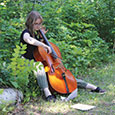Clear, flexible, and expressive articulation can often be an illusive goal. In the quest for clarity, flutists often form detrimental habits or hold misconceptions due to a lack of understanding, misleading terminology, and careless practice.
Tongue Placement and Motion
Depending on a player’s native language, the tongue placement for the T or D syllable that is used to start a note might be slightly different. Some people feel comfortable with a more forward position of the tongue, closer to the teeth or even the lips, while others find it natural more back. For native English speakers, the natural position for T or D is usually with the flat part directly above the tip of the tongue touching somewhere on the fleshy ridge above the top teeth. A placement of the tongue that hinders sound quality by blocking the throat, or a position that rests the tongue consistently on the lower lip, causes problems with tone quality and embou-chure flexibility. No matter the style of articulation, the tongue should be relaxed and the motion should be swift, minimal, and efficient. Any large motion can lead to a heavy sound or lack of coordination with the fingers.
Not an Attack but a Release
The terminology used to identify the start of a note made with the tongue is somewhat misleading. Though it is often called an attack, it is in essence, a release. An attack suggests something violent, or a large motion, similar to an arm throwing a punch, or a rocket being launched at a target far away. It implies forward motion. While the preparation of the tongue is indeed a forward motion, the initial sound from the articulation comes from the tongue being released from its striking position. The amount of pressure from the release of the tongue will determine the style and clarity of the beginning of the note. The D syllable with minimal pressure generally produces a softer attack, while the T gives a bit more point to the front of the note. Releasing either syllable with a greater amount of pressure will produce a much more pungent or defined attack.
One Sided Viewpoint
Much focus is put on the onset of the note, the left side, but every note also has a center, and a right side. Think of it as an articulation sandwich: the filling is the center of the sound and core of the tone, while the left and right sides make up the tonguing and release. Regardless of the type of articulation, emphasize focus on the center of the sound. The quality of a note can be thought of as 25% left side, 50% center, and 25% release, or right side. If the start and end of the notes are not clear and elegantly executed, up to 50% of the quality and projection of the tone may be lost.
Double-Tonguing
When double-tonguing is learned, students often make the mistake of using a large tongue motion in an attempt to retrieve the K or G syllable. K and G are created when the back of the tongue touches the back of the roof of the mouth, also known as the soft palette. An overly large motion can lead to closing the throat by pulling the tongue back too far, as well as a heavy articulation and uncoordinated technique. For a fast and secure articulation, keep the front of the tongue close to a T or D striking position, while alternating with a K or G syllable.
A T or D single tongue is typically used by a player for a number of years before double-tonguing is introduced. In many languages, more words are generally used with the T or D sounds than K or G. Due to these two factors, it is natural that the T or D syllable comes more easily and is stronger in a double-tonguing pattern. Flutists should practice clarity of articulation for the K or G syllable independently.
Vowels
Much focus is put on the action of the tongue, especially for double-tonguing, but articulation unevenness often occurs when the vowel is stopped or abruptly cut. Vowels and consonants should be the same length. The type of vowel used might vary slightly due to the musical circumstance, however an ah vowel (ah as in top) generally works well for a standard fast double-tonguing. An ee vowel, (ee as in sleep) is generally good to avoid because the back of the tongue is raised in this position and subtly closes the throat and blocks the air stream. An oo vowel, (oo as in soup) brings the jaw slightly forward and longtime usage of this syllable can add unwanted tension to the jaw. In the ah position, the jaw is naturally open at its hinge point and the tongue is lower allowing for more resonance in the throat and oral cavity.
Uh-Oh! Uneven Double Tonguing
Flutists often practice with various dotted rhythms to clear up uneven double-tonguing. This can in fact lead to improvement, but the reason for the problem should be examined. Say the expression Uh-Oh! Notice the glottal stop at the end of Uh (similar to an ut as in but) before saying Oh. When a flutist has uneven double-tonguing they are often adding this extra and unwanted stop. For example: T-AH-(UH)-K-AH. The addition of an extra glottal stop cuts off the vowel after the initial consonant in an over attempt to prepare for the K syllable. This is not necessary; each vowel should run directly into each consonant without interruption.
Slow to Fast Practice
As flutists speed up a double-tongued passage, quality is often lost. A common mistake when playing faster is to play shorter. This essentially closes the vowel, and the projection of the tone is lost. Try to speak with all consonants and incredibly short vowels; enunciation is clear, however the words are not, and the message is not expressed. The space ratio between consonant and vowel should stay the same as the tempo increases in order to keep quality of sound and coordination with the fingers.
Staccato, Legato and Duration
Articulation and note duration are not the same thing. If a note is marked with a staccato, the indication is to play the note with separation; however the staccato itself does not define the duration of the note. For example, if there are three staccato notes in succession, an eighth note followed by two sixteenth notes, then the eighth note staccato should have a slightly greater value proportional to its rhythm. Legato on the other hand suggests connectivity, but does not have to mean lack of definition with the tongue. Often when a composer uses tenuto markings, it indicates that the performer should sustain the notes, but also use the tongue in a clear and defined manner. Staccato does not necessarily mean to use a heavier or sharper tongue, and longer does not mean to play with less articulation. Consider the musical style and gesture to decide how to balance the expressivity of the articulation with the proper duration.
Practice Solutions
Practice all consecutive short notes long without altering the style or pressure of the release of the tongue that is desired for the passage at optimal tempo. Play each note with a very subtle crescendo at the end of the note leading into the next articulation. Be sure that the length of the vowel extends directly into the next consonant, without closing the vowel off beforehand. After you have attained the sound quality you desire on a note, shorten it up until you get to optimal length. Be sure at all times that the quality of the sound does not change.
In addition to using the common practice method of alternating between various combinations of TK or DG, KT or GD, or all T or all K, etc., practice beginning a note with the breath or diaphragm tongueless attack. Simply begin a note without articulation, starting the air stream with the vowel sound ah, making sure that the aperture does not change and the note stays centered in pitch. Abdominal support should be consistent with a slight bit of extra pressure or raising of the support to practice the release of the vowel. Minimal movements are always best for efficiency.
Lastly, pay careful attention to the motion and usage of the tongue when not playing the flute. Flutists practice articulation in their daily lives without even realizing it. The way people enunciate words coupled with the resonate sonority and vocal quality can create speech that is compelling and defined. If problems or patterns occur, think about how it could be affecting your flute playing. Work for optimal and resonate projection of your voice when speaking. Enunciate and shape words with warmth, affection and inflection, and then incorporate this care and attention to detail into your flute practice.






